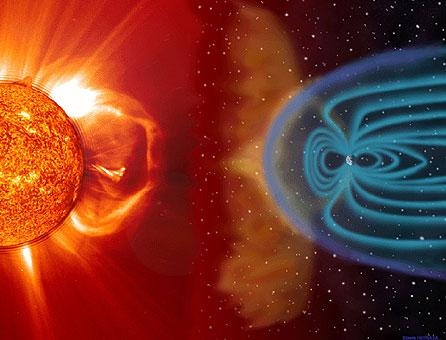What
are the dangers facing mankind beyond the safety of our atmosphere?
Our early explorers faced many challenges as they sailed the oceans of our planet. Storms, rocks, reefs, starvation and lack of fresh water to name a few. However the dangers of space travel are more deadly and our trip to Mars will not be without peril.
We may take Earth's atmosphere for granted but it offers protection from radiation, moderates the temperature, provides breathable oxygen, allows water to boil at 100 oC and even protects us from small meteors. Lets take a look at some of the challenges of space travel.
The
Van Allen Radiation Belts are a sea of energetic charged particles, namely
protons and electrons, that are held in place around the Earth by its
magnetic field. Sometimes these charged particles strike the upper atmosphere
and cause a brilliant display of light called a polar aurora.
Highly energised particles exist between the belts that can penetrate
one millimeter of lead. Some sceptics suggest that the Apollo missions
could not have landed humans on the Moon as travel through the Van Allen
Belts would be deadly. However the danger of exposing astronauts to unacceptable
doses of radiation is minimised by planning the space crafts route so
that astronauts spend minimal time in the Van Allen Belts.
)

The early explorers had to contend with high winds that could propel the
ship along the water or blow it off course. Astronauts have to contend
with the ever present solar wind which can be viewed as an extension of
the Sun's outer layer called the corona and extends deep into space. It
travels through space at 400 km/s. To put it into perspective it can go
from Melbourne to Sydney in just over two seconds. The solar wind is made
up of charged particles that constantly fly off the Sun at a rate of one
million tons per second. However this is such a miniscule amount, when
compared to the mass of the Sun, that it is insignificant. Unlike our
early explorers who would literally be blown away by the gale force winds
they encountered, astronauts would simply feel very little as these highly
energised particles simply pass through their body smashing into vital
molecules, such as DNA, inside their cells causing irreversible damage.

The early explorers could not have imagined such dangers and even in the weightlessness of space when all seems calm and peaceful something sinister is taking place in the astronaut's body. With every day that passes in the weightlessness of space the astronaut's bones are been depleted of calcium and muscles weaken until they are unable to support the astronaut when they return to Earth. Special exercise machines have significantly reduced the muscle and bone wastage suffered in weighless environments.
Space has no temperature of which to speak of. There is nothing in space that can heat up, no molecules or particles . Our atmosphere is full of molecules and particles that absorb heat and give air a temperature. However, things that are left in direct sunlight in space can heat up to 121 C. When in the shade an object can drop to -129 C. There is no atmosphere to moderate the temperature and this is one of the functions of the space suite. The lack of atmosphere has other problems, besides the obvious lack of oxygen, the absence of air creates a situation where liquids boil at body temperature.